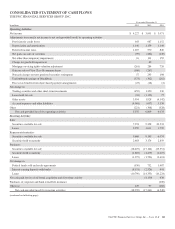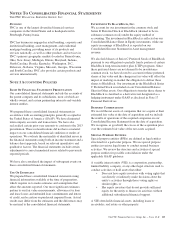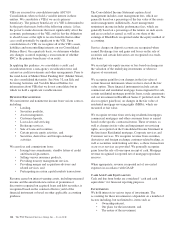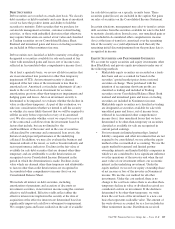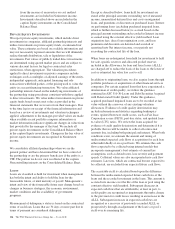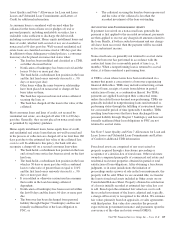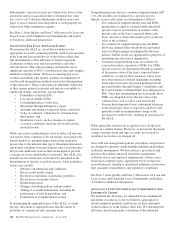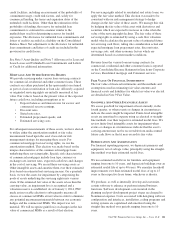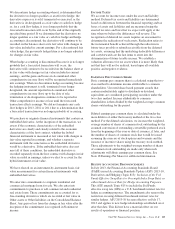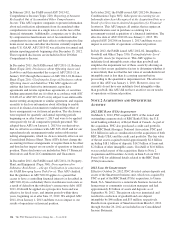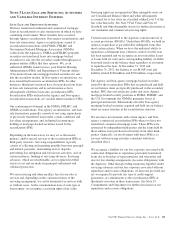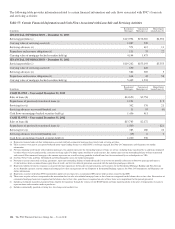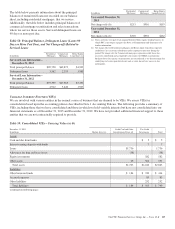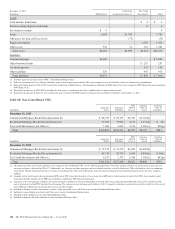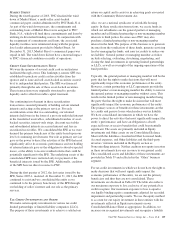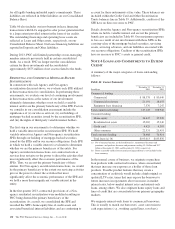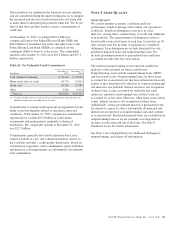PNC Bank 2013 Annual Report Download - page 139
Download and view the complete annual report
Please find page 139 of the 2013 PNC Bank annual report below. You can navigate through the pages in the report by either clicking on the pages listed below, or by using the keyword search tool below to find specific information within the annual report.credit facilities, including an assessment of the probability of
commitment usage, credit risk factors, and, solely for
commercial lending, the terms and expiration dates of the
unfunded credit facilities. Other than the estimation of the
probability of funding, the reserve for unfunded loan
commitments is estimated in a manner similar to the
methodology used for determining reserves for funded
exposures. The allowance for unfunded loan commitments and
letters of credit is recorded as a liability on the Consolidated
Balance Sheet. Net adjustments to the allowance for unfunded
loan commitments and letters of credit are included in the
provision for credit losses.
See Note 5 Asset Quality and Note 7 Allowances for Loan and
Lease Losses and Unfunded Loan Commitments and Letters
of Credit for additional information.
M
ORTGAGE
A
ND
O
THER
S
ERVICING
R
IGHTS
We provide servicing under various loan servicing contracts
for commercial, residential and other consumer loans. These
contracts are either purchased in the open market or retained
as part of a loan securitization or loan sale. All newly acquired
or originated servicing rights are initially measured at fair
value. Fair value is based on the present value of the expected
future cash flows, including assumptions as to:
• Deposit balances and interest rates for escrow and
commercial reserve earnings,
• Discount rates,
• Stated note rates,
• Estimated prepayment speeds, and
• Estimated servicing costs.
For subsequent measurements of these assets, we have elected
to utilize either the amortization method or fair value
measurement based upon the asset class and our risk
management strategy for managing these assets. For
commercial mortgage loan servicing rights, we use the
amortization method. This election was made based on the
unique characteristics of the commercial mortgage loans
underlying these servicing rights. Specific risk characteristics
of commercial mortgages include loan type, currency or
exchange rate, interest rates, expected cash flows and changes
in the cost of servicing. We record these servicing assets as
Other intangible assets and amortize them over their estimated
lives based on estimated net servicing income. On a quarterly
basis, we test the assets for impairment by categorizing the
pools of assets underlying the servicing rights into various
strata. If the estimated fair value of the assets is less than the
carrying value, an impairment loss is recognized and a
valuation reserve is established. As of January 1, 2014, PNC
made an irrevocable election to subsequently measure all
classes of commercial MSRs at fair value in order to eliminate
any potential measurement mismatch between our economic
hedges and the commercial MSRs. The impact was not
material. We will recognize gain/(loss) on changes in the fair
value of commercial MSRs as a result of that election.
For servicing rights related to residential real estate loans, we
apply the fair value method. This election was made to be
consistent with our risk management strategy to hedge
changes in the fair value of these assets. We manage this risk
by hedging the fair value of this asset with derivatives and
securities which are expected to increase in value when the
value of the servicing right declines. The fair value of these
servicing rights is estimated by using a cash flow valuation
model which calculates the present value of estimated future
net servicing cash flows, taking into consideration actual and
expected mortgage loan prepayment rates, discount rates,
servicing costs, and other economic factors which are
determined based on current market conditions.
Revenue from the various loan servicing contracts for
commercial, residential and other consumer loans is reported
on the Consolidated Income Statement in line items Corporate
services, Residential mortgage and Consumer services.
F
AIR
V
ALUE
O
F
F
INANCIAL
I
NSTRUMENTS
The fair value of financial instruments and the methods and
assumptions used in estimating fair value amounts and
financial assets and liabilities for which fair value was elected
are detailed in Note 9 Fair Value.
G
OODWILL
A
ND
O
THER
I
NTANGIBLE
A
SSETS
We assess goodwill for impairment at least annually, in the
fourth quarter, or when events or changes in circumstances
indicate the assets might be impaired. Finite-lived intangible
assets are amortized to expense using accelerated or straight-
line methods over their respective estimated useful lives. We
review finite-lived intangible assets for impairment when
events or changes in circumstances indicate that the asset’s
carrying amount may not be recoverable from undiscounted
future cash flows or that it may exceed its fair value.
D
EPRECIATION
A
ND
A
MORTIZATION
For financial reporting purposes, we depreciate premises and
equipment, net of salvage value, principally using the straight-
line method over their estimated useful lives.
We use estimated useful lives for furniture and equipment
ranging from one to 10 years, and depreciate buildings over an
estimated useful life of up to 40 years. We amortize leasehold
improvements over their estimated useful lives of up to 15
years or the respective lease terms, whichever is shorter.
We purchase, as well as internally develop and customize,
certain software to enhance or perform internal business
functions. Software development costs incurred in the
planning and post-development project stages are charged to
Noninterest expense. Costs associated with designing software
configuration and interfaces, installation, coding programs and
testing systems are capitalized and amortized using the
straight-line method over periods ranging from one to 10
years.
The PNC Financial Services Group, Inc. – Form 10-K 121


